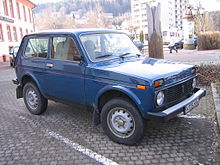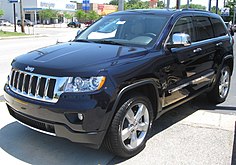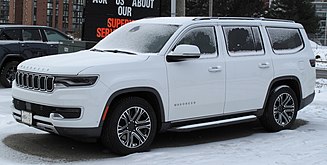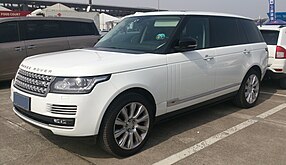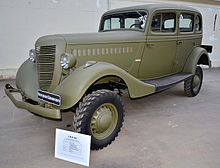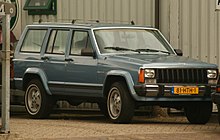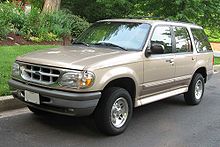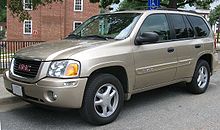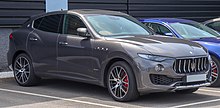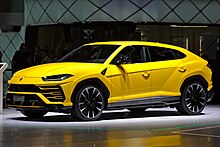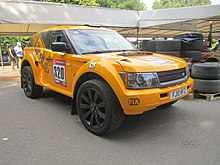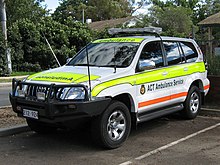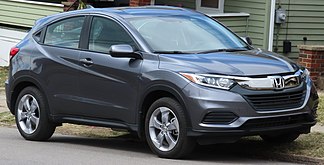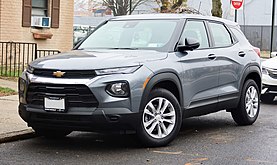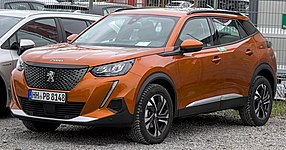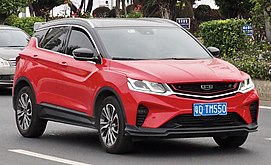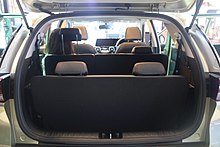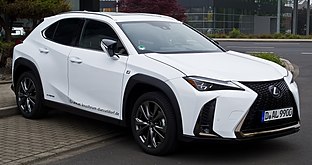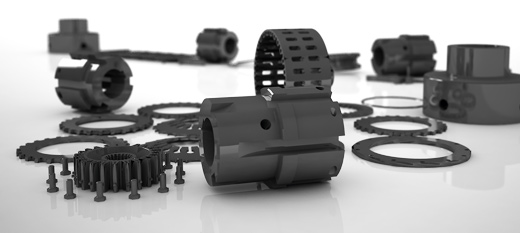A sport utility vehicle (SUV) is a car classification that combines elements of road-going passenger cars with features from off-road vehicles, such as raised ground clearance and four-wheel drive.
There is no commonly agreed-upon definition of an SUV and usage of the term varies between countries. Thus, it is «a loose term that traditionally covers a broad range of vehicles with four-wheel drive.»[1] Some definitions claim that an SUV must be built on a light truck chassis; however, broader definitions consider any vehicle with off-road design features to be an SUV. A crossover SUV is often defined as an SUV built with a unibody construction (as with passenger cars); however, the designations are increasingly blurred because of the capabilities of the vehicles, the labelling by marketers, and electrification of new models.[2]
The predecessors to SUVs date back to military and low-volume models from the late 1930s, and the four-wheel-drive station wagons and carryalls that began to be introduced in 1949. The 1984 Jeep Cherokee (XJ) is considered to be the first SUV in the modern style.[3][4] Some SUVs produced today use unibody construction; however, in the past, more SUVs used body-on-frame construction. During the late 1990s and early 2000s, the popularity of SUVs greatly increased, often at the expense of the popularity of large sedans and station wagons.
More recently, smaller SUVs, mid-size, and crossovers have become increasingly popular. SUVs are currently[when?] the world’s largest automotive segment and accounted for 45.9% of the world’s passenger car market in 2021.[5]
SUVs have been criticized for a variety of environmental and safety-related reasons. They generally have poorer fuel efficiency and require more resources to manufacture than smaller vehicles, contributing more to climate change and environmental degradation.[6] Between 2010 and 2018 SUVs were the second-largest contributor to the global increase in carbon emissions worldwide.[7] Their higher center of gravity increases their risk of rollovers. Their larger mass increases their stopping distance, reduces visibility, and increases damage to other road users in collisions. Their higher front-end profile makes them at least twice as likely to kill pedestrians they hit.[8] Additionally, the psychological sense of security they provide influences drivers to drive less cautiously.[9]
Definitions[edit]
There is no universally accepted definition of the sport utility vehicle.[10] Dictionaries, automotive experts, and journalists use varying wordings and defining characteristics, in addition to regional variations of usage by both the media and the general public. The auto industry also has not settled on one definition of the SUV.[10]
The actual term «Sport Utility Vehicle» did not come into wide popular usage until the late 1980s. Before then, such vehicles were marketed as four-wheel drives, jeeps, station wagons, or other terms.[citation needed]
American English[edit]
Automotive websites’ descriptions of SUVs range from specifically «combining car-like appointments and wagon practicality with steadfast off-road capability» with «chair-height seats and picture-window visibility»[11] to the more general «nearly anything with available all-wheel drive and raised ground clearance».[12] It is also suggested that the term «SUV» has replaced «jeep» as a general term for off-road vehicles.[13]
American dictionary definitions for SUVs include:
- «rugged automotive vehicle similar to a station wagon but built on a light-truck chassis»[14]
- «automobile similar to a station wagon but built on a light truck frame»[15]
- «large vehicle that is designed to be used on rough surfaces but that is often used on city roads or highways»[14]
- «passenger vehicle similar to a station wagon but with the chassis of a small truck and, usually, four-wheel drive»[16]
British English[edit]
In British English, the terms «4×4» (pronounced «four-by-four»), «jeep», four wheel drive, or «off-road vehicle» are generally used instead of «sport utility vehicle». The derogatory term «Chelsea tractor» is also commonly used, due to the perceived popularity of the vehicles with urban residents of Chelsea, London, and their likeness to vehicles used by farmers.[17] However, in the 2020s, the term SUV has entered usage in the United Kingdom[18][19][20][21]
The Collins English Dictionary defines a sport utility vehicle as a «powerful vehicle with four-wheel drive that can be driven over rough ground. The abbreviation SUV is often used.»[22]
Other countries[edit]
In Europe, the term SUV is generally used for road-oriented vehicles, described as «J-segment» by the European Commission.[23][24][25] «Four-by-four» or the brand name of the vehicle is typically used for off-road-oriented vehicles. Similarly, in New Zealand, vehicles designed for off-road use are typically referred to as «four-wheel drives» instead of SUVs.
Government regulations[edit]
In the United States, many government regulations simply have categories for «off-highway vehicles» which are loosely defined and often result in SUVs (along with pick-up trucks and minivans) being classified as light trucks.[10][26] For example, corporate average fuel economy (CAFE) regulations previously included «permit greater cargo-carrying capacity than passenger carrying volume» in the definition for trucks, resulting in SUVs being classified as light trucks.[27]
This classification as trucks allowed SUVs to be regulated less strictly than passenger cars under the Energy Policy and Conservation Act for fuel economy, and the Clean Air Act for emissions.[28] However, from 2004 onwards, the United States Environmental Protection Agency (EPA) began to hold sport utility vehicles to the same tailpipe emissions standards as cars for criteria pollutants, though not greenhouse gas emissions standards as they were not set until 2010.[29][30] In 2011, the CAFE regulations were changed to classify small, two-wheel-drive SUVs as passenger cars.[31]
However, the licensing and traffic enforcement regulations in the United States vary from state to state, and an SUV may be classified as a car in some states but as a truck in others.[32] For industry production statistics, SUVs are counted in the light truck product segment.[33]
In India, all SUVs are classified in the «Utility Vehicle» category per the Society of Indian Automobile Manufacturers (SIAM) definitions and carry a 27% excise tax.[34] Those that are 4 metres (13 feet) long, have a 1,500 cc (92 cu in) engine or larger, along with 170 mm (6.7 in) of ground clearance, are subject to a 30% excise duty.[35]
In Australia, SUV sales were helped by having lower import duties than passenger cars. Up until January 2010, SUVs were subject to a 5% import tariff, compared with 10% for passenger cars.[36][37]
Characteristics[edit]
Chassis[edit]
Many years after most passenger cars had transitioned to unibody construction, most SUVs continued to use a separate body-on-frame method, due to being based on the chassis from a light truck, commercial vehicle, pickup truck, or off-road vehicle.
The first mass-produced unibody four-wheel-drive passenger car was the Russian 1955 GAZ-M20 Pobeda M-72,[38][39] which could be considered the first crossover car. The 1977 Lada Niva was the first off-road vehicle to use both a unibody construction and a coil-sprung independent front suspension. The relatively compact Niva is considered a predecessor to the crossover SUV and combines a hatchback-like passenger car body with full-time four-wheel drive, low-range gearing, and lockable center differential.
Nonetheless, unibody SUVs remained rare until the 1984 Jeep Cherokee (XJ) was introduced and became a sales success. The introduction of the 1993 Jeep Grand Cherokee resulted in all Jeep SUV models using unibody construction,[40] with many other brands following suit since the mid-1990s. Today, most SUVs in production use a unibody construction and relatively few models continue to use body-on-frame construction.
Body style[edit]
SUVs are typically of a two-box design similar to a station wagon. The engine compartment is in the front, followed by a combined passenger/cargo area (unlike a sedan, which has a separate trunk/boot compartment).
Up until approximately 2010, many SUV models were available in two-door body styles.[41] Since then, manufacturers began to discontinue the two-door models as the four-door models became more popular.[42][43][44]
A few two-door SUVs remain available, such as the body-on-frame Suzuki Jimny, Mahindra Thar, Toyota Land Cruiser Prado, Ford Bronco,[45] and Jeep Wrangler[46][47] as well as the Range Rover Evoque crossover SUV.
Safety[edit]
SUVs typically have high ground clearance and a tall body. This results in a high center of mass, which made SUVs more prone to roll-over accidents.[48][49] In 2003, SUVs were quoted as 2.5 times more likely to roll over in a crash than regular cars and that SUV roofs were more likely to cave in on passengers than in other cars, resulting in increased harm to passengers.[48][50]
Between 1991 and 2001, the United States saw a 150% increase in sport-utility vehicle rollover deaths. In 2001, though roll-overs constituted just 3% of vehicle crashes overall, they caused over 30% of occupant fatalities in crashes;[48] and in crashes where the vehicle did roll over, SUV occupants in the early 2000s were nearly three times as likely to be killed as other car passengers.[48] Vehicles with a high center of gravity do sometimes fail the moose test of maneuverability conducted by Swedish consumer magazine Teknikens Värld, for example, the 1997 Mercedes-Benz A-Class and 2011 Jeep Grand Cherokee.[51]
The increasing popularity of SUVs in the 1990s and early 2000s was partly due to buyers perceiving that SUVs provide greater safety for occupants, due to their larger size and raised ride height.[48][52][53][54] Regarding the safety of other road users, SUVs are exempted from U.S. regulation stating that a passenger car bumper must protect the area between 16 and 20 inches (41 and 51 cm) above the ground. This often increases the damage to the other car in a collision with an SUV, because the impact occurs at a higher location on the other car.[55][56] In 2000–2001, 60% of fatal side-impact collisions were where the other vehicle was an SUV, an increase from 30% in 1980–1981.[57]
The introduction of electronic stability control and rollover mitigation, as well as increased analysis of the risks of a rollover, led the IIHS to report in 2015 that «the rollover death rate of 5 per million registered vehicle years for 2011 models is less than a quarter of what it was for 2004 models. With ESC dramatically reducing rollover risk, the inherent advantages offered by SUVs’ greater size, weight, and height emerge more clearly. Today’s SUVs have the lowest driver death rate of any vehicle type.»[58]
The high danger for cyclists and pedestrians of being seriously injured or even killed by SUV drivers has caused some public protests against SUVs in urban areas.[59] In 2020, a study by the U.S.-based IIHS found that, of a sample of 79 crashes from three urban areas in Michigan, SUVs caused more serious injuries compared to cars when impacts occurred at greater than 31 km/h (19 mph). The IIHS noted the sample size of the study was small and that more research is needed.[60] The popularity of SUVs contributed to an increase in pedestrian fatalities in the U.S. during the 2010s, alongside other factors such as distracted and drunk driving.[61]
Environmental impact[edit]
SUVs generally have poorer fuel efficiency than smaller cars,[62] and thus contribute more to environmental degradation and global warming.
SUVs emit about 700 megatonnes of carbon dioxide per year,[6] a gas that is linked to global warming. According to the International Energy Agency, from 2010 SUVs have been the second-largest contributor to the increase in global CO2 emissions, second only to the power sector.[6]
SUVs were responsible for all of the 3.3 million barrels a day growth in oil demand from passenger cars between 2010 and 2018, whereas efficiency improvements in smaller cars saved over 2 million barrels a day, with electric cars reducing oil demand by under 100,000 barrels a day.[6]
Whereas SUVs can be electrified,[63] or converted to run on a variety of alternative fuels, including hydrogen,[64] their (manufacturing) emissions will always be larger than smaller electric cars.[65] On average, SUVs consume about a quarter more energy than medium-size cars.[6] Furthermore, the vast majority of these vehicles are not converted to use alternative fuels.
Between 2010 and 2018 SUVs were the second largest contributor to the global increase in carbon emissions worldwide.[7]
Types of SUV[edit]
Crossover SUV[edit]
The «crossover SUV» segment (also known as «CUVs» or simply «crossovers») has become increasingly popular since around 2010. Crossovers are often based on a platform shared with a passenger car, as a result, they typically have better comfort and fuel economy, but less off-road capability (many crossovers are sold without all-wheel drive) than pickup truck-based SUVs.[66][67][68]
The difference between crossovers and other SUVs is sometimes defined as a crossover being built using a unibody platform (the type used by most passenger cars), while an SUV is built using a body-on-frame platform (the type used by off-road vehicles and light trucks).[69][70][71] However, these definitions are often blurred in practice, since unibody vehicles are also often referred to as SUVs.[72][73] Also, crossover is a relatively recent term and early unibody SUVs (such as the 1984 Jeep Cherokee) are rarely called crossovers. Due to these inconsistencies, the term SUV is often used as a catch-all for both crossovers and SUVs.[74]
Outside of the United States, the term crossover tends to be used for C-segment (compact) or smaller vehicles, with large unibody vehicles—such as the Mercedes-Benz GLS-Class, BMW X7, and Range Rover—usually referred to as SUVs rather than crossovers. In the United Kingdom, a crossover is sometimes defined as a hatchback model with raised ride height and SUV-like styling features.[75][76]
- Examples: Category:Crossover sport utility vehicles ( 415 )
Mini SUV[edit]
The smallest size class of SUVs is the «mini SUV». In Japan, SUVs under 3,400 mm (133.9 in)—such as the Mitsubishi Pajero Mini—are included in the kei car category and therefore attract lower taxes.
Many recent vehicles labeled as mini SUVs are technically subcompact crossovers and are built on the platform of a subcompact (also called supermini or B-segment) passenger car.
- Examples: Category:Mini sport utility vehicles ( 108 )
-
-
Suzuki Jimny, off-road mini SUV
Compact SUV[edit]
The «compact SUV» is the next bigger-size class after mini SUVs.
Many recent vehicles labeled as compact SUVs are technically compact crossovers and are built on the platform of a compact (C-segment) passenger car.
- Examples: Category:Compact sport utility vehicles ( 234 )
-
Nissan Xterra, compact truck-based SUV
-
-
Jeep Cherokee, unibody SUV
Mid-size SUV[edit]
The next larger size is called the «mid-size SUV». Some mid-size SUVs are based on platforms shared with passenger cars and therefore, are crossovers. Other mid-size SUVs are based on compact or mid-size pickups.
- Examples: Category:Mid-size sport utility vehicles ( 225 )
-
Toyota Fortuner (also called SW4), mid-size truck-based SUV
-
Ford Bronco, off-road mid-size SUV with a compact two-door version available
-
Jeep Grand Cherokee, unibody mid-size SUV
Full-size SUV[edit]
Full-size SUVs are the largest size of commonly produced SUVs. Some, such as the Ford Expedition, and Chevrolet Tahoe, are marketed for their off-road capabilities, and others, such as the Lincoln Navigator and Cadillac Escalade, are marketed as luxury vehicles. While a few full-size SUVs are built on dedicated platforms; most share their platforms with full-sized pickups.
- Examples: Category:Full-size sport utility vehicles ( 71 )
-
Jeep Wagoneer, full-size SUV on a pickup truck-based platform
-
Cadillac Escalade, full-size luxury SUV
-
Mercedes-Benz GLS-class, full-size unibody SUV
Extended-length SUV[edit]
Some North American SUVs are available as a long-bodied version of a full-size SUV, which is called an «extended-length SUV» like the Ford Expedition EL and the Chevrolet Suburban. The additional length is used to provide extra space for rear passengers or cargo. As per the full-size SUVs they are based on, most extended-length SUVs are built on dedicated platforms, full-sized pickups, or heavy-duty pickups.
Extended-length SUVs are mostly sold in North America but may also be exported to other markets in small numbers.
-
GMC Yukon XL, extended-length SUV
-
Ford Excursion, extended-length SUV based on a heavy-duty truck platform
-
Range Rover L, extended-length unibody SUV
- Examples: Category:Expanded length sport utility vehicles ( 16 )
Coupe SUV[edit]
Some SUVs or crossovers with sloping rear rooflines are marketed as «coupe crossover SUVs» or «coupe SUVs», even though they have four side doors for passenger access to the seats and rear hatches for cargo area access.
History[edit]
1930s to 1948[edit]
Just before and during World War II, prototypes and low-volume production examples of military cars with sedan or station wagon-type bodies and rugged, off-road capable four-wheel drive chassis began to appear around the world. These early models included the 1936 Kurogane Type 95 from Japan, the 1938 GAZ-61 from Russia as well as the 1941 Volkswagen Kommandeurswagen and 1936 Opel Geländesportwagen[77] from Germany. An early predecessor to the design of modern SUVs[citation needed] was the 1940 Humber Heavy Utility, a four-wheel-drive off-road vehicle built on the chassis of the Humber Super Snipe passenger car.[78]
The most prohibitive initial factors to the potential civilian popularity of an SUV-like car were their cost and the availability of certain critical parts. Before the war, adding four-wheel drive to a car almost doubled its cost.[79] Compared to a common, rear-wheel drive vehicle, any 4WD (four-wheel drive) needed many essential extra components, including a transfer case, a second differential, and constant-velocity joints for the driven front axle—which were expensive due to the precision involved in this required manufacturing gears and other specialized parts. Before World War II, these were produced in the United States by only a few specialized firms with limited production capacity. Due to the increase in demand for parts for the war effort, in the spring of 1942 Ford, Dodge, and Chevrolet joined in fabricating these parts in mass quantities, boosting their production more than 100-fold.[80]
An early usage of the term was the 1947 Crosley CC Four Sport Utility model, which used a convertible wagon body style and is therefore unrelated to the design of later SUVs.[81][82][83]
1949 to 1970s[edit]
Subaru Leone 4WD station wagon
AMC Eagle Sport station wagon
Several models of carryall wagons began to be offered with four-wheel drive, beginning in 1949 when the Willys Jeep Station Wagon introduced the option of four-wheel drive.[84][85] Four-wheel-drive versions of the Chevrolet Suburban were introduced for 1955, followed by the International Harvester Travelall in 1956 (credited as being the first full-size SUV)[86] and the Power Wagon Town Wagon in 1957.[86][87]
Developed as a competitor to the Jeep CJ, the compact International Harvester Scout was introduced in 1961, offering either two- or four-wheel drive and a variety of engine options. The Harvester Scout provided many other options designed to appeal to a wide range of customers for numerous uses as well.[88] The 1963 Jeep Wagoneer (SJ) introduced a sophisticated station wagon body design that was more carlike than any other four-wheel-drive vehicle on the market.[89] The 1967 Toyota Land Cruiser FJ55 station wagon was the first comfort-oriented version of the Land Cruiser off-road vehicle. The two-door Chevrolet K5 Blazer (and related GMC K5 Jimmy) were introduced for 1969, and the two-door International Harvester Scout II was introduced in 1971. The first European luxury off-road vehicle was the 1970 Range Rover Classic, which was marketed as a luxury car for both on-road and off-road usage.[90][91]
In 1972 Subaru Leone 4WD wagon was introduced in Japan, which was not designed as an off-road vehicle, but a version of the front-wheel-drive passenger car. Some argue that this was the first SUV.[92] It was also classified as a commercial vehicle in the home market, just like later SUVs.[93]
The first relevant usage of the term SUV was in advertising brochures for the full-sized 1974 Jeep Cherokee (SJ), which used the wording «sport(s) utility vehicle» as a description for the vehicle.[94][95] The 1966 Ford Bronco included a «sport utility» model; however, in this case it was used for the two-door pickup truck version.[96]
The VAZ-2121 (now designated Lada Niva Legend) was the first mass-market 4WD unibody car in some markets in 1977.[97] The AMC Eagle introduced in the North American market in 1979, and is often called the first mass-market «crossover», although that term had not been coined at the time.[98][99] In contrast to truck or utility-vehicle based designs and the Niva that was purpose-built for rural areas, American Motors Corporation (AMC) utilized a long-serving existing car platform and designed a new automatic full-time AWD system.[100][101] The AMC Eagle was developed as a passenger car offering numerous comfort, luxury, and convenience features in sedan, coupe, and station wagon body styles.[citation needed] It was first with «SUV styling on a raised passenger-car platform combined with AWD.»[2] Four Wheeler magazine described the AMC Eagle as «the beginning of a new generation of cars».[102]
1980s to 1990s[edit]
The compact-sized 1984 Jeep Cherokee (XJ) is often credited as the first SUV in the modern understanding of the term.[103] The use of unibody construction was unique at the time for a four-wheel drive and also reduced the weight of the new Cherokee. It also appealed to urban families due to having a more compact size (compared to the full-size Wagoneer and previous generation Cherokee SJ models) as well as a plush interior resembling a station wagon.[103] As the new Cherokee became a major sales success, the term «sport utility vehicle» began to be used in the national press for the first time.[103] «The advent and immediate success of AMC/Jeep’s compact four-door Cherokee turned the truck industry upside down.»[104]
The U.S. corporate average fuel economy (CAFE) standard was introduced in 1975 to reduce fuel usage, but included relaxed regulations for «light trucks» to avoid businesses paying extra taxes for work vehicles. This created a loophole that manufacturers increasingly exploited since the 1980s oil glut (which started an era of cheap gasoline), whereby SUVs were designed to be classified as light trucks despite their primary use as passenger vehicles to receive tax concessions and less stringent fuel economy requirements.[105] This enabled manufacturers to sell more profitable, larger, more polluting vehicles, instead of the smaller, less polluting, less profitable cars, that the CAFE regulations intended.
For example, the United States Environmental Protection Agency agreed to classify the new Jeep Cherokee as a light truck following lobbying from its manufacturer; the Cherokee was then marketed by the company as a passenger vehicle.[52] This increased the SUV boom as other manufacturers introduced their own SUVs in response to the compact Cherokee taking sales from their regular cars.[106]
In 1994 the U.S. Environmental Protection Agency began classifying vehicles by «market class». For SUVs in 1994 they included three Jeep models, the Cherokee, Grand Cherokee and Wrangler. Two Ford models were the Bronco and the Explorer. Six General Motors models including the GMC Jimmy, the Yukon, and the Suburban 1500; the Chevrolet Suburban 1500, and the Blazer (1500 and S10); the Geo Tracker (Convertible or Van); and finally the Oldsmobile Bravada. Eleven Japanese models classified as SUVs were the Toyota 4Runner and Land Cruiser; the Honda Passport; the Nissan Pathfinder; the Mazda Navajo; the Mitsubishi Montero; the Isuzu Amigo, Rodeo, and Trooper; and the Suzuki Samurai and Sidekick. From Europe the three Land Rover models, the Range Rover, the Defender and the Discovery were classified as SUVs.
By late 1996 Consumers Digest magazine was calling the trend an «SUV craze»,[107] and by 1999 the U.S. sales of SUVs and light trucks for the first time exceeded sales of regular passenger cars.[48]: 2
2000s[edit]
By 2003, there were 76 million SUVs and light trucks on U.S. roads, representing approximately 35% of the vehicles on the road.[48]
Car manufacturers were keen to promote SUV sales over other types of cars due to higher profits in the segment. An SUV could be sold with a profit margin of US$10,000 or more (US$18,000 per SUV in the case of the Ford Excursion), while compact cars were often sold at a loss of a few hundred dollars per car.[108][109][110] As a result, several manufacturing plants were converted from car production to SUV production (such as the General Motors plant in Arlington, Texas in 1996), and many long-running U.S. sedan models were discontinued.[111][112][113]
From the mid-2000s until 2010, U.S. sales of SUVs and other light trucks experienced a dip due to increasing fuel prices and then a declining economy. From 2008 until 2010, General Motors closed four assembly plants that were producing SUVs and trucks.[114] Sales of SUVs and light trucks sales began to recover in 2010, as fuel prices decreased and the North American economy improved.[115]
2010s to 2020s[edit]
In 2019, the International Energy Agency (IEA) reported that the global number of SUVs and crossovers on the road multiplied by six since 2010—from 35 million to 200 million vehicles, and their market share has grown to 40 percent of worldwide new light-vehicle sales at the end of the decade.[116]
By 2013, small and compact SUVs had increased to become the third-largest market segment.[33] Since the early 2000s, new versions have been introduced to appeal to a wider audience, such as crossovers and other small SUVs.[117] Larger SUVs also remained popular, with sales of General Motors’ large SUV models increasing significantly in 2013.[118]
In 2015, global sales of SUVs overtook the «lower medium car» segment, to become the largest market segment, accounting for 22.9% of «light vehicle» sales in 2015.[117] The following year, worldwide SUV sales experienced further growth of 22%. The world’s fastest-growing SUV markets in 2014–2015 were: China (+ 47.9%), Italy (+ 48.6%), Spain (+ 42%), Portugal (+ 54.8 %), and Thailand (+ 56.4%).[117] The SUV segment further grew to 26% of the global passenger car market in 2016, then to 36.8% of the market in Q1–Q3 of 2017.[119][120][117]
In the U.S. at the end of 2016, sales of SUVs and light-duty trucks had surpassed traditional car sales for the year by over 3 million units.[121] Manufacturers continued to phase out the production of sedan models, replacing them with new models of SUVs.[122]
Luxury brands have increasingly introduced SUV or crossover models in the 2010s. For example: Rolls-Royce Cullinan, Bentley Bentayga, Aston Martin DBX, Maserati Levante, Lamborghini Urus, and Ferrari Purosangue.[123]
In 2019 SUVs made up 47.4% of U.S. sales compared to only 22.1% for sedans.[124]
Motorsport[edit]
SUVs have competed in various off-road racing competitions, such as the Dakar Rally, Baja 1000, FIA Cross-Country Rally World Cup, King of the Hammers, and Australasian Safari. SUVs have also competed in the Trophee Andros ice-racing series.
Nicknames[edit]
Several derogatory or pejorative terms for SUVs are based on the combination of an affluent suburb name and «tractor», particularly for expensive vehicles from luxury brands. Examples include «Toorak Tractor» (Melbourne, Australia),[125][126] «Chelsea Tractor» (London, England)[127] and «Remuera Tractor» (Auckland, New Zealand). These terms relate to the theory that four-wheel drive capabilities are not required by affluent SUV owners, and that the SUV is purchased as a status symbol rather than for practical reasons.
In Norway, the term Børstraktor (‘Stock Exchange Tractor’) serves a similar purpose.[128] In the Netherlands, SUVs are sometimes called «P.C. Hooft-tractors» after the exclusive P.C. Hooftstraat Amsterdam shopping street.[129]
Commercial SUVs[edit]
A commercial SUV is an SUV or crossover, that is used for commercial purposes. The category is very similar to panel trucks since the Chevrolet Suburban (an SUV) had panel truck versions, which were used for commercial purposes.
The first SUV-like vehicle that had commercial versions was the Chevrolet Suburban panel truck. Panel trucks by American manufacturers were built until the late 1970s.
While panel trucks manufactured by European manufacturers were rare, commercial versions of off-road vehicles were very common, Land Rover manufactured commercial versions of the Land Rover and the Defender. Commercial SUVs are factory-built and most of them are not independent conversions, which means they can be bought from dealerships and showrooms.[130]
Examples of SUVs used as commercial vehicles in Europe include: Citroen C5 Aircross Commercial SUV,[131] the Land Rover Discovery, the Dacia Duster Flika,[132] and the Mitsubishi Pajero.
See also[edit]
Wikimedia Commons has media related to SUVs.
- Criticism of sport utility vehicles
- Esuvee
- Four-wheel drive
- Off-road vehicle
- List of sport utility vehicles
- Recreational vehicle
- Crossover city car (A-segment SUV)
References[edit]
Notes[edit]
- ^ «SUV Meaning: What is an SUV?». Car and Driver. 13 April 2020. Retrieved 30 August 2022.
- ^ a b Wardlaw, Christian (15 September 2021). «What is a Crossover SUV?». J.D. Power. Retrieved 30 August 2022.
- ^ «1984 Jeep Cherokee». The Washington Post. 2 February 2003. Retrieved 30 August 2022.
- ^ Jordan, Michael (September 1983). «1984 Jeep Cherokee Reimagines the 4×4 for a New Age». Car and Driver. Retrieved 30 August 2022.
- ^ «New registrations of SUVs in key car markets, 2010-2021 – Charts – Data & Statistics». IEA. Retrieved 14 July 2022.
- ^ a b c d e Cozzi, Laura; Petropoulos, Apostolos. «Growing preference for SUVs challenges emissions reductions in passenger car market». International Energy Agency. Archived from the original on 4 February 2020. Retrieved 18 February 2020.
On average, SUVs consume about a quarter more energy than medium-size cars. As a result, the global fuel economy worsened caused in part by the rising SUV demand since the beginning of the decade, even though efficiency improvements in smaller cars saved over 2 million barrels a day, and electric cars displaced less than 100,000 barrels a day. In fact, SUVs were responsible for all of the 3.3 million barrels a day growth in oil demand from passenger cars between 2010 and 2018, while oil use from other types of cars (excluding SUVs) declined slightly.
- ^ a b Kommenda, Niko. «SUVs second biggest cause of emissions rise, figures reveal». The Guardian. Retrieved 21 June 2022.
- ^ Lawrence, Eric D.; Bomey, Nathan; Tanner, Kristi (1 July 2018). «Death on foot: America’s love of SUVs is killing pedestrians». Detroit Free Press. Archived from the original on 14 December 2019. Retrieved 24 December 2019.
- ^ Gladwell, Malcolm (5 January 2004). «Big and Bad». The New Yorker. Archived from the original on 19 February 2016. Retrieved 30 October 2021.
- ^ a b c Bradsher 2002, p. 4.
- ^ Bumbeck, Mike (August 2013). «Utility in Style – The 1972 Jeep Wagoneer blends an iconic design with modern driveability». Hemmings Classic Car. Retrieved 26 October 2020.
- ^ DeMuro, Doug (October 2013). «SUV vs. Crossover: What’s the Difference?». autotrader.com. Retrieved 26 October 2020.
- ^ Glucksberg, Sam (2001). Understanding Figurative Language: From Metaphor to Idioms. Oxford University Press. p. 112. ISBN 9780198027126. Retrieved 26 October 2020.
- ^ a b «Definition of SUV». Merriam-Webster. Archived from the original on 5 January 2018. Retrieved 26 October 2020.
- ^ «Definition of Sport-utility Vehicle». Merriam-Webster. 3 January 2018. Archived from the original on 8 December 2017. Retrieved 26 October 2020.
an automobile similar to a station wagon but built on a light truck frame
- ^ Webster’s New World College Dictionary (Fourth ed.). Houghton Mifflin Harcourt.
- ^ «Stereotype of ‘Chelsea tractor’ reflects reality of urban SUV sales, says report». The Guardian. 7 April 2021. Retrieved 9 January 2023.
- ^ «Top 10 Best family SUVs 2021». Autocar. 20 January 2021. Retrieved 9 May 2021.
- ^ «Search Chambers: four-by-four». Chambers 21st Century Dictionary. Retrieved 25 July 2021.
- ^ «Search Chambers: jeep». Chambers 21st Century Dictionary. Retrieved 25 July 2021.
- ^ «Search Chambers: off-road vehicle». Chambers 21st Century Dictionary. Retrieved 25 July 2021.
- ^ Collins Cobuild Advanced English Dictionary. HarperCollins. Retrieved 10 November 2019.
- ^ «Regulation (EEC) No 4064/89 — Merger Procedure» (PDF). ec.europa.eu. Luxemburg: Office for Official Publications of the European Communities. 17 March 1999. p. 2. Archived (PDF) from the original on 27 March 2009. Retrieved 3 March 2019.
- ^ «Car prices within the European Union / Prix des voitures au sein de l’Union européenne / Autopreise in der europäischen Union» (PDF). ec.europa.eu (in English, French, and German). Brussels: Publications Office of the European Union. 1 January 2011. Archived (PDF) from the original on 6 November 2011. Retrieved 3 March 2019.
- ^ «Impact on the Competitiveness of the European Automotive Industry of Potential FTA with India and ASEAN» (PDF). europa.eu. p. 8. Archived from the original (PDF) on 29 April 2013.
- ^ Davis, Stacy C.; Williams, Susan E.; Boundy, Robert G. (2016). «Transportation Energy Data Book» (PDF) (35th ed.). Oak Ridge National Laboratory. pp. 3–5. Archived (PDF) from the original on 6 January 2018. Retrieved 25 July 2021.
- ^ Fuhs, Allen (2008). Hybrid Vehicles: and the Future of Personal Transportation. CRC Press. p. 263. ISBN 9781420075342. Retrieved 8 April 2019.
- ^ Yacobucci, Brent D. (17 April 2003). «Sport Utility Vehicles, Mini-Vans, and Light Trucks: An Overview of Fuel Economy and Emissions Standards» (PDF). CRS Report for Congress. Archived (PDF) from the original on 16 August 2017. Retrieved 23 December 2011.
- ^ «The Plain English Guide to the CleanAirAct» (PDF). United States Environmental Protection Agency. April 2007. p. 8. Archived (PDF) from the original on 14 October 2015. Retrieved 6 December 2017.
- ^ «Light Duty Vehicle Emissions». 29 June 2022. Retrieved 10 January 2023.
EPA first set greenhouse gas emission standards for vehicles in 2010, which took effect in MY 2012.
- ^ «Fact #726: SUVs: Are They Cars or Trucks?». Office of Energy Efficiency & Renewable Energy (EERE) U.S. Department of Energy. 7 May 2012. Archived from the original on 12 January 2014. Retrieved 12 January 2014.
- ^ Fuhs, Allen (2008). Hybrid Vehicles: and the Future of Personal Transportation. CRC Press. p. 7. ISBN 9781420075342. Retrieved 6 December 2017.
- ^ a b «Production of Small and Compact SUVs Shifts to Top Gear in North America, Finds Frost & Sullivan». prnewswire.com (Press release). 14 January 2014. Retrieved 14 January 2014.
- ^ Bhattacharya, Sindhu (20 December 2013). «Budget 2013: Why SUV found special mention this budget day». Firstpost. Retrieved 6 December 2017.
- ^ «SUV tax creating uneven playing field: Mahindra». NDTV. 2 May 2013. Retrieved 6 December 2017.
- ^ «Tariff reduction will soften price rises». Blog.autopeople.com.au. 18 November 2008. Archived from the original on 6 January 2009. Retrieved 16 November 2010.
- ^ «Matters of great import». Carpoint. 6 January 2010. Retrieved 16 November 2010.
- ^ «M-72 all-terrain vehicle». spb.ru (in Russian). Retrieved 13 April 2019.
- ^ Thompson, Andy (2008). Cars of the Soviet Union. Somerset, U.K.: Haynes Publishing. p. 57.
- ^ «Jeep Grand Cherokee Review». Edmunds. Retrieved 10 April 2011.
- ^ Hunting, Benjamin (21 April 2019). «The 6 Best (and 5 Weirdest) 2 Door SUVs of All Time». DrivingLine. Retrieved 16 January 2021.
- ^ DeMuro, Doug (1 April 2013). «Attention Automakers: Please Stop Selling Two-Door SUVs». The Truth About Cars. Retrieved 16 January 2021.
- ^ DeMuro, Doug (21 June 2017). «Every Single Two-Door SUV Has Failed». Autotrader. Retrieved 16 January 2021.
- ^ «Toyota Sharpens Best-Selling Prado Range» (Press release). Australia: Toyota. 14 October 2013. Archived from the original on 6 March 2016. Retrieved 16 January 2021.
- ^ Hyatt, Kyle; Szymkowski, Sean (15 July 2020). «2021 Ford Bronco pricing: Here’s how much the 2-door and 4-door cost». Roadshow. Retrieved 16 January 2021.
- ^ «2020 Jeep Wrangler 2-Door: Lowest Cost to Own Among Off-Road SUVs». Kelley Blue Book. 5 February 2020. Retrieved 16 January 2021.
- ^ Lee, Christian (2007). High-Performance Jeep Wrangler TJ Builder’s Guide. CarTech. p. 14. ISBN 9781932494266. Retrieved 16 January 2021.
- ^ a b c d e f g SUV safety: issues relating to the safety and design of sport utility vehicles: hearing before the Committee on Commerce, Science, and Transportation. United States Senate, One Hundred Eighth Congress, first session. 26 February 2003. p. 18. ISBN 9781422334188 – via Diane Publishing.
- ^ Valdes-Dapena, Peter (16 October 2019). «Volvo’s first fully electric car will also be one of its safest cars ever». CNN Business. Retrieved 30 August 2022.
- ^ Penenberg, Adam (2003). Tragic Indifference: One Man’s Battle with the Auto Industry over the Dangers of SUVs. HarperBusiness. p. 12. ISBN 0-06-009058-8.
- ^ «Jeep Grand Cherokee fails Swedish moose test, lessons for U.S. consumers». Consumer Reports. 13 July 2012. Retrieved 27 August 2020.
- ^ a b Bradsher 2002.
- ^ «The 50 Worst Cars Of All Time». Time. 7 September 2007. Archived from the original on 13 September 2007. Retrieved 23 May 2010.
- ^ Croft, Robin (2006). «Folklore, families and fear: understanding consumption decisions through the oral tradition». Journal of Marketing Management. 22 (9/10): 1053–1076. doi:10.1362/026725706778935574. ISSN 0267-257X. S2CID 144646252.
- ^ «When cars and SUVs crash: Bumper mismatch boosts costs». CNN. 2 December 2010. Retrieved 14 April 2019.
- ^ «Q&As – Vehicle size and weight». U.S.: Insurance Institute for Highway Safety. April 2018. Retrieved 11 February 2019.
- ^ «Side-impact crash test program». Insurance Institute for Highway Safety. Archived from the original on 30 December 2010.
- ^ «Improved vehicle designs bring down death rates».
- ^ Oltermann, Philip (9 September 2019). «Berliners call for 4×4 ban after four people killed in collision». The Guardian. ISSN 0261-3077. Retrieved 12 May 2020.
- ^ «New study suggests today’s SUVs are more lethal to pedestrians than cars». US: Insurance Institute for Highway Safety. 16 June 2020. Retrieved 16 January 2021.
- ^ Dean, Tamara (22 November 2022). «‘He was fast … he ran you right over’: what it’s like to get hit by an SUV». The Guardian. Retrieved 10 April 2023.
- ^ «Source The AutoChannel». The Auto Channel. Retrieved 31 December 2010.
- ^ «Kreisel Electric and Arnold Schwarzenegger present the world’s first electrified Hummer H1». Austria: Kreisel. Retrieved 24 January 2020.
- ^ Lianos, Miguel (23 June 2004). «Hydrogen cars ready to roll — for a price». U.S.: NBC. Retrieved 24 January 2020.
- ^ Tobert, Andrew (7 September 2019). «Bigger is not better – how SUVs are killing the climate». Greenpeace International. Retrieved 24 January 2020.
- ^ «Smart Buying Essentials What is a Crossover Vehicle?». Intellichoice. Archived from the original on 17 July 2011. Retrieved 27 July 2015.
- ^ Isidore, Chris (9 January 2006). «GM and Ford’s New Cross to Bear». CNN Money. Retrieved 27 July 2015.
- ^ «Crossover 101». aol.com. Archived from the original on 16 April 2016.
- ^ «Difference between a crossover vehicle and SUV?». hertzcarsales.co.uk. 30 January 2019. Archived from the original on 6 November 2020. Retrieved 22 April 2019.
- ^ «What is the Difference Between Crossovers and SUVs? « Harbin Automotive». harbinautomotive.com. Retrieved 22 April 2019.
- ^ «What’s the Difference Between an SUV, a Crossover, & a CUV?». thenewswheel.com. 30 March 2017. Retrieved 22 April 2019.
- ^ «SUV vs. Crossover: What’s the Difference?». autotrader.com. Retrieved 22 April 2019.
- ^ «SUVs vs. Crossovers: What’s the Difference?». usnews.com. Retrieved 22 April 2019.
- ^ «The Difference Between SUVs and Crossover Cars». carwriteups.co.uk. 9 April 2018. Retrieved 22 April 2019.
- ^ «What’s the difference between a crossover, SUV and 4×4?». carbuyer.co.uk. Retrieved 22 April 2019.
- ^ «SUV vs Crossover: What are the Differences and Similarities?». leasefetcher.co.uk. Retrieved 22 April 2019.
- ^ Carlsson, Mårten (26 June 2018). «Opel Terrängsportbil» [Opel Off-Road Car]. Klassiker (in Swedish). Sweden. Retrieved 11 July 2019.
- ^ «10 Strange Military Vehicles of World War II». wonderslist.com. 30 January 2014. Retrieved 10 April 2019.
- ^ Allen, Jim (10 January 2016). «Origins Of The Jeep: Birthing A 75-Year Legend». Four Wheeler Network. U.S. Retrieved 11 February 2019.
- ^ Thomson, Harry C.; Mayo, Lida (2003). The Ordnance Department: procurement and supply. United States Army in World War II: The technical services. Washington, D.C.: Office of the Chief of Military History, Dept. of the Army (published 1960). p. 274 – via United States Army Center of Military History.
- ^ «History 101: The Crosley Automobile». Daily KOS. U.S. 26 May 2014. Retrieved 24 February 2018.
- ^ «Details on Crosley CC Models 1946 — 1948». Crosley Automobile Club. U.S. Retrieved 24 February 2018.
- ^ «Crosley 1948». Archived from the original on 23 February 2018 – via Classic Car Catalogue.
- ^ «1960 Willys Four-Wheel-Drive Station Wagon: Your (Great-) Grandfather’s SUV». Autoweek. 15 February 2007. Retrieved 5 October 2017.
- ^ Greg. «The Very First Sport Utility Vehicle: The Jeep Station Wagon». Autoroundup. Archived from the original on 5 October 2017. Retrieved 6 December 2017.
- ^ a b Allen, Jim (1 November 2012). «1959 International Harvester B-120 Travelall – Four Wheeler Magazine». Four Wheeler Network. Archived from the original on 7 January 2018. Retrieved 7 January 2018.
- ^ «The 1958 Station Wagons». Changing Times: The Kiplinger Magazine. Vol. 12, no. 2. February 1958. p. 22. Retrieved 9 January 2018.
- ^ «Why We Love Them: International Harvester Scout». Bring a Trailer. 27 May 2018. Retrieved 15 October 2019.
- ^ Lewin, Tony; Borroff, Ryan (2003). How to Design Cars Like a Pro: A Comprehensive Guide to Car Design from the Top Professionals. MotorBooks/MBI Publishing. p. 191. ISBN 9780760316412.
- ^ «1970 Range Rover advertisement». YouTube. 11 February 2018. Archived from the original on 18 May 2019. Retrieved 13 April 2019.
- ^ «Old Range Rover ad». YouTube. 13 June 2009. Archived from the original on 29 October 2021. Retrieved 13 April 2019.
- ^ «Subaru Leone 4WD Wagon was the first SUV». outbacktravelaustralia.com.au. Retrieved 30 August 2022.
- ^ 自動車ガイドブック [Automobile Guide Book 1975~76] (in Japanese), vol. 22, Japan: Japan Automobile Manufacturers Association, 31 October 1975, pp. 279–280, 0602-509072-2228
- ^ «1974 model year Jeep brochure picture – Cherokee page». U.S.: Jeep. 1973. Retrieved 4 January 2018.
- ^ «1974 model year Jeep Cherokee brochure – front». U.S.: Jeep. 1973. Retrieved 4 January 2018.
- ^ «1966 Ford Bronco U-100 4-Wheel Drive models & features brochure». U.S.: Ford. 1965. Archived from the original on 3 January 2018. Retrieved 4 January 2018.
- ^ «The Lada Niva: Russia’s Forgotten Off-Road SUV». 25 December 2019.
- ^ Baxter, Eric (13 July 2011). «Who coined the term ‘crossover vehicle?’«. howstuffworks. Retrieved 9 May 2021.
- ^ Gold, Aaron (9 May 2017). «AMC Eagle: No, Seriously, This Was the First Crossover SUV». Autotrader. Retrieved 9 May 2021.
- ^ Hunting, Benjamin (14 February 2021). «How Bad Was The Lada Niva, The Ultra-Cheap Alternative Russian 4X4?». DrivingLine. Retrieved 30 August 2022.
- ^ Appel, Tom (9 May 2019). «Review Flashback! 1980 AMC Eagle». The Daily Drive by Consumer Guide. Retrieved 9 May 2021.
- ^ Brubaker, Ken (27 December 2018). «Firing Order: That Time I Bought an AMC Eagle». Four Wheeler. Retrieved 30 August 2022.
- ^ a b c Bradsher 2002, p. 40.
- ^ Ludel, Moses (1995). Toyota truck & Land Cruiser owner’s bible. Robert Bentley. p. 18. ISBN 978-0-8376-0159-5. Retrieved 24 June 2011.
- ^ «From the Battlefield to the Soccer Field». Traffic Safety Center Online Newsletter. Summer 2005. Archived from the original on 10 March 2012. Retrieved 8 January 2013.
- ^ Bradsher 2002, p. 41.
- ^ «SUV Craze». Consumers Digest. 1996.
- ^ Schoenberger, Robert (6 June 2008). «As buyers shun SUVs, expect to pay more for that small car». Cleveland Business News. Retrieved 16 November 2010.
- ^ «Ford idle, for now». USA Today. 16 October 2008. Retrieved 23 May 2010.
- ^ White, Jerry (27 May 2000). «GM, Ford idle 1,365 workers-auto industry layoffs signal coming downturn in US economy». Wsws.org. Retrieved 16 November 2010.
- ^ Maynard, Micheline (28 October 2006). «End of the Line for Ford Taurus». The New York Times. Retrieved 15 March 2018.
- ^ «Final Ford Taurus interview». ABC News. 26 July 2007. Archived from the original on 29 October 2021.
- ^ Neff, John (19 October 2006). «So long, friend. Ford producing last Taurus next week». Autoblog. Retrieved 26 July 2007.
- ^ Van Praet, Nicolas (4 June 2008). «Caw Girds For War». Financial Post. U.S. Archived from the original on 16 February 2009. Retrieved 11 February 2019.
- ^ Healey, James (30 July 2010). «Surprise: Sales of big SUVs surging faster than small cars». USA Today. Retrieved 23 April 2012.
- ^ Webster, Ben (14 November 2019). «Soaring demand for SUVs exacerbates climate crisis». The Times. U.K. Retrieved 26 October 2020.
- ^ a b c d «SUVs Become the Largest and Fastest-Growing Automotive Segment in 2015». Euromonitor International. 9 August 2016. Archived from the original on 6 August 2017. Retrieved 26 October 2020.
- ^ Wayland, Michael (20 January 2019). «2015 GMC Yukon and Chevy Suburban, Tahoe: GM expects new SUVs to continue industry dominance». MLive. Michigan, U.S. Retrieved 26 October 2020.
- ^ «World Best Selling SUV 2016». Focus2Move. 25 January 2017. Archived from the original on 29 January 2017. Retrieved 6 January 2018.
- ^ «World Best Selling SUV 2017». Focus2Move. 29 November 2017. Archived from the original on 6 January 2018. Retrieved 6 January 2018.
- ^ «Auto Sales December 2016 compared to 2015». The Wall Street Journal. 4 January 2017. Archived from the original on 5 January 2017. Retrieved 28 October 2020.
- ^ Jeneault, Elizabeth (17 January 2017). «Hyundai Trims Fat, Looks to Add More SUVs to Lineup». suvs.com. Retrieved 28 October 2020.
- ^ Burn, Jonathan (19 March 2018). «Ferrari SUV confirmed fastest SUV crown targeted». Auto Express. Retrieved 10 November 2019.
- ^ Voelk, Tom (21 May 2020). «Rise of S.U.V.s: Leaving Cars in Their Dust, With No Signs of Slowing». The New York Times. Retrieved 14 September 2020.
- ^ «The Australian travel slang dictionary». Australian Traveller. Australia. 9 June 2015. Retrieved 18 February 2018.
- ^ «The evolution of the SUV». eMotor. 3 January 2018. Archived from the original on 17 February 2018. Retrieved 18 February 2018.
- ^ Campbell, Denis (26 September 2004). «Terminator guns for the Chelsea Tractor». The Guardian. London. Retrieved 19 July 2009.
- ^ Sæter, Embret (26 November 2009). «Bloddopet børstraktor» (in Norwegian). DN.no. Retrieved 2 January 2012.
- ^ Nizet, Rik (14 January 2014). «Lamborghini lanceert ook PC Hooft-tractor» [Lamborghini also launches a PC Hooft-tractor]. De Ondernemer (‘The Entrepreneur’) (in Dutch). De Persgroep. Retrieved 17 February 2018.
- ^ Chin, Joshua (27 July 2020). «The Wonderful World Of The Commercial SUV Market». Automacha. Retrieved 25 December 2020.
- ^ «Citroën C5 Aircross Commercial SUV». Ireland: Citroën. Retrieved 25 December 2020.
- ^ Mihalascu, Dan (21 May 2018). «Dacia Duster Fiskal light commercial vehicle debuts in Austria». Drivemag. Romania. Retrieved 25 December 2020.
Bibliography[edit]
- Bradsher, Keith (2002). High and Mighty: SUVs – The World’s Most Dangerous Vehicles and How They Got That Way. New York: PublicAffairs. ISBN 1-58648-123-1.
- Chapman, Giles (2005). SUV: The World’s Greatest Sport Utility Vehicles. London: Merrell Publishers. ISBN 1858942748.
- Henshaw, Peter (2005). The Ultimate Guide to SUVs and Off-Road Vehicles. Edison, NJ, USA: Chartwell Books. ISBN 0785818200.
- Jacobs, David H. (1998). Sport Utility Vehicles: The Off-Road Revolution. New York: Todtri Book Publishers. ISBN 1577170857.
В современной классификации автомобилей в пору запутаться не то, что простому автолюбителю, а и эксперту автомобильного рынка. Все потому, что сами автопроизводители вносят сумятицу в определенные термины. Ниже мы остановимся на классификации кроссоверов SUV, TUV, а также XUV. Что это обозначает и в чем различие?
Первый термин — SUV, является аббревиатурой от Sports Utility Vehicle (спортивно-утилитарный автомобиль).
Так обозначают кроссоверы, вроде Hyundai Creta и Renault Duster. Они относятся к классу «В». В класс «С» причислены Toyota RAV4 и Honda CRV.
Обозначение XUV появилось благодаря индийским автопроизводителям компании Mahindra. Они посчитали, что их автомобиль не вписывается в существующие рамки и придумали свое. Так и появился Mahindra XUV 500.
Обозначению TUV мы обязаны также индусам. Такой индекс присваивается небольшим внедорожникам. Например, модель Mahindra TUV 300, схожая по характеристикам с Suzuki Jimny. Вероятна и наша «Нива» могла бы претендовать на индекс TUV.

А какие малоизвестные индексы встречались вам в обозначении автомобилей других классов? Поделитесь интересной информацией в комментариях.
оцените материал
-
👍
0
-
😄
0
-
😲
0
-
😡
0
-
😥
0
From Wikipedia, the free encyclopedia
Subcompact crossover SUV is an automobile segment used to describe the smallest segment of crossover SUV, a type of sport utility vehicle, below the compact crossover SUV. Subcompact crossover SUVs are usually based on a platform of a subcompact (also known as supermini or B-segment) passenger car, although some high-end subcompact crossover models are based on a compact car (C-segment).[2] The segment started to gain traction during early to mid-2010s when the number of models and sales figures rapidly increased in major markets such as North America and Europe.[3][4] In 2019, around 22 percent of SUV global sales were contributed by subcompact crossovers.[5]
The segment is particularly popular in Europe, India, and Brazil where they account for 37 percent, 75 percent, and 69 percent of total SUV sales in 2018 respectively.[6] The best-selling vehicle is the segment in 2019 was the Honda HR-V, recording 622,154 units being sold worldwide.[1]
Terminology[edit]
The «subcompact crossover SUV» or «subcompact crossover» term is most commonly used in North America, where the «subcompact» and «crossover» terms originated from.[4][7][8]
The segment is also known as «B-segment SUV», «B-SUV»,[9] «small SUV»,[10][11] or «subcompact CUV».[12] It is also known with several other terms depending on the market, including «compact crossover» or «compact SUV»,[13] which differs with the more common definition of a compact crossover SUV, which is a class larger and belongs to the C-segment. Classification of a certain model may also vary between markets due to differences in regional definitions, competition and pricing.
Characteristics[edit]
Subcompact crossovers commonly use the same platform of similarly-sized subcompact/B-segment hatchbacks or sedans,[14][15][16] while some high-end models may be based on a compact cars (C-segment).[17] Crossovers in this segment typically have limited off-road capabilities with the majority adopting front-wheel-drive layout, although many subcompact crossovers offer all-wheel-drive.[18] Depending on the market and the manufacturer, subcompact crossover SUVs typically have an exterior length under 4,400 mm (173.2 in).[19][6]
According to IHS Markit, vehicles from this segment were considered by customers as cheap to purchase and run, offer a «desirable lifestyle styling» and higher seating position.[3] Other advantages also include higher ground clearance, convenient ingress/egress, larger headroom, and larger legroom space compared to B-segment/subcompact hatchbacks.[20][21]
Despite built on the same platforms as subcompact cars and using much of the same technology, customers are shown to be willing to purchase them with a higher price. A study by JATO Dynamics showed that average price of subcompact SUVs sold in 2021 in the European market was €26,366, compared with €20,699 for subcompact or small cars.[22]
History[edit]
The first-generation Honda HR-V was released in 1998 mainly for the Japanese and European markets, and has been considered as one of the first subcompact crossover.[23] Its exterior length stood between 4,000–4,110 mm (157.5–161.8 in), sold with either 3-doors and 5-doors, and was offered with an all-wheel-drive option. However, the release of the Nissan Juke in 2010 which was oriented towards Europe and North America was argued to have helped define and start the development of the almost non-existent segment at the time.[3]
As the result of the increasing popularity of the segment, from mid-2010s, manufacturers began to phase out subcompact hatchbacks and sedans in favor of this segment in several markets since it offers higher profit margins, particularly in North America.[24]
Due to its expanding market share, it is common in this segment for one brand to offer more than one model at different price points and segmentation. For example, as of 2022, Volkswagen offered three models in the segment in Europe, which are T-Roc, T-Cross, and Taigo.[22]
Criticism[edit]
According to tests conducted in the UK by Which?, vehicles from this class returned an average of around 7 percent worse fuel economy and 7 percent higher CO2 tailpipe emissions than equivalent hatchbacks such as the Ford Fiesta and Renault Clio, and was said to be marginally less efficient than the medium hatchback class such as the Volkswagen Golf.[25]
Markets[edit]
United States[edit]
In the North American market where larger vehicles are preferred, the segment has been largely marketed to urban drivers and consumers looking to downsize to a smaller, more efficient vehicle.[21] While not as popular as the larger compact crossovers, the segment has experienced major growth in the U.S. market in its brief history.[4]
The Nissan Juke, which was unveiled at the 2010 New York International Auto Show to be sold for the 2011 model year was considered the first model in the segment, apart from the luxury Mini Countryman.[26] Many other nameplates in the segment appeared between 2013 and 2015, which included the Buick Encore, Chevrolet Trax, Fiat 500X, Ford EcoSport, Honda HR-V, Jeep Renegade, and Subaru Crosstrek.[27][28]
In 2015, there were 10 subcompact crossover nameplates in the U.S., totalling 411,774 units sold or 2.4 percent of the overall market. In that year, subcompact crossovers outsold subcompact cars for the first time in history.[29] In the following year, the Jeep Renegade was the first in the segment to cross the 100,000-sales threshold.[4]
In 2018, the segment consisted of 16 nameplates and recorded 784,073 sales, capturing 12 percent of the U.S. crossover market and 4.5 percent of overall U.S. automobile market, according to the Automotive News Data Center. In comparison, the share of subcompact cars fell to 2.4 percent of the U.S. market in 2018 from 5.4 percent in 2010, while compact cars declined to 9.9 percent from 12.4 percent in the same period.[4]
In 2019, the Hyundai Kona became the first subcompact crossover SUV to win the North American Utility Vehicle of the Year.[30] Around 50 percent of subcompact crossover SUVs sold in the U.S. in 2021 were produced in South Korea.[31]
- Top 3 best-sellers in the U.S., 2021[32]
-
Honda HR-V (137,090 sold)
-
-
Europe[edit]
European figures for B-segment SUV (including off-roaders) had rapidly increased during the 2010s. Between 2000 and 2009, sales volume only doubled 60,000 units in 2000 to 125,000 units according to JATO Dynamics. However, IHS Markit noted that sales of the segment in Europe between 2010 and 2016 increased nearly tenfold from 134,000 units to 1.13 million units.[3] Industry analyst LMC Automotive predicts sales will reach 2.3 million in 2023 and will steadily rise to reach almost 3 million by 2028.[22]
In 2010, Nissan introduced the Juke which was produced in the UK and Japan.[33] Many other nameplates entered the market between 2012 and 2013, which included the Dacia Duster, Chevrolet Trax, Ford EcoSport, Opel Mokka, Peugeot 2008, Suzuki SX4 S-Cross, and Renault Captur.[34][35][36]
Volkswagen entered the segment in 2017 with the release of the Volkswagen T-Roc, positioned below the Tiguan.[37][38] Other models such as the Citroën C3 Aircross, SEAT Arona and Hyundai Kona further boosted growth in 2017. In that year, B-SUV accounted for 10 percent of the overall automobile market.[39]
Several manufacturers have changed their product mix by introducing subcompact crossovers to replace mini MPVs in Europe due to the popularity of the former and the declining sales of the latter. Models from the segment was seen a fit replacement for mini MPVs.[40][41] The examples are the Citroën C3 Aircross which replaced the Citroën C3 Picasso and Opel Crossland X replacing the Opel Meriva.[3][42][43]
According to data from JATO Dynamics, sales in 2021 totalled 2,018,791 units, representing 37 percent of the SUV market and 17 percent of the overall automobile market.[44] Petrol-powered vehicles dominated the segment with 72 percent of sales in the first 10 months of 2021, followed by diesel at 14 percent. Full-electric models accounted for 5.1 percent of sales in the same period.[22] According to JATO’s data for Europe, seven European car brands that focused their efforts on developing SUVs, have seen their overall sales in the B and C segments fall dramatically between 2001 and 2021.[45]
- Top 3 best-sellers in Europe, 2021[46]
-
Peugeot 2008 (194,653 sold)
-
-
Renault Captur (158,580 sold)
India[edit]
In India, subcompact crossovers with a length dimension below 4 m (157.5 in) are commonly called «subcompact SUVs»[47] or «compact SUVs»[48][49][50] by journalists, and the larger ones are usually referred as «mid-size SUV».[51] The distinction was due to the Indian vehicle dimensions regulations which imposes heavier tax for vehicles longer than 4 m (157.5 in).[52][53]
Renault entered the segment in 2012 when company saw a gap in the SUV market in India, which was filled by the Duster. The vehicle has proven to be a sales success in its initial release as its major competitors was from a segment above and a segment below.[54][55][56] Major growth of the B-SUV class continued in between 2015 and 2016, when the Hyundai Creta (introduced in 2015) and Maruti Suzuki Vitara Brezza (2016) was introduced to the market. Sales of B-SUVs increased 509 percent in January–May 2016 compared to the same period in 2015, while it gained 7.2 percent of overall market share.[57]
The first mainstream sub-4 metre SUV to be launched in India was the Ford EcoSport (in 2012) which was a high-selling model due to the lack of competition,[58] followed by the Maruti Suzuki Vitara Brezza. Soon after, many other manufacturers followed suit, with 10 models available in the sub-segment as of 2021.[59]
- Top 3 best-sellers in India, 2021[60]
-
Hyundai Creta (125,437 sold)
-
-
Tata Nexon (108,577 sold)
China[edit]
In 2018, sales of subcompact crossovers in the country accounts for 19 percent of the total SUV market.[6] The Baojun 510 is notable for being the highest-selling newly-introduced automobile nameplate in world’s history. It received the record in January 2018 after recording 416,883 sales in its first 12 months in market, which was said to be the highest in the world for a new car.[61]
- Top 3 best-sellers in China, 2021[62]
-
Honda XR-V (191,267 sold)
-
Honda Vezel (155,828 sold)
-
Geely Binyue (144,367 sold)
Brazil[edit]
The segment is commonly known as «compact SUV» (Portuguese: SUV compacto) in the country. The Ford EcoSport is the first model of this segment when it was introduced in 2003. It is based on the Ford Fiesta B-segment hatchback and the Ford Fusion mini MPV. It went on to become a global model when the second-generation model was introduced in 2012,[63] although it lost its segment market leader status after newcomers such as the Honda HR-V and Jeep Renegade was released in 2015.[64]
- Top 3 best-sellers in Brazil, 2021[65]
-
Jeep Renegade (73,927 sold)
-
Hyundai Creta (64,764 sold)
-
Australia[edit]
In Australia, the segment is known as the «small SUV»,[66] «compact SUV»[67] or «light SUV»[68] segment. In 2021, it is the third-largest automobile segment in the market after pickup trucks and medium SUV at 13.7 percent share.[69] As of 2022, there are more than 30 models from the segment being offered in the country.[67]
Three-row vehicles[edit]
Subcompact crossovers with three-row seating has been developed for various markets. For example, the SsangYong Tivoli XLV or Tivoli Air offers third row seats by extending the rear overhang of the standard subcompact Tivoli.[70] The Hyundai Alcazar introduced in 2021 is an extended Hyundai Creta, with longer exterior length and wheelbase, and has been marketed as a vehicle from a segment above,[71] while the Kia Sonet offered a third row seating in Indonesia, a market dominated by three-row vehicles, without extending the body.[72] The Honda BR-V has been developed as a three-row, seven-seater crossover while slotted as a B-segment SUV.[73]
Luxury vehicles[edit]
Numerous luxury car brands produce and market subcompact crossover SUVs, usually as an entry-level SUV offering of the respective brands. They are known by a variety terms, such as subcompact luxury crossover SUV, luxury subcompact SUV, premium small SUV, premium compact crossover and luxury small SUV.[74] Subcompact luxury crossover SUVs are usually based on the platform of a compact car (C-segment), while some models are based on a mid-size car (D-segment) or a subcompact (B-segment) platform.
Vehicles in this segment are commonly built on a C-segment car platform or above. While being significantly more expensive, they offer similar driving and convenience advantages as mainstream subcompact crossover SUVs, with larger exterior dimensions, more refined interiors, more advanced technologies, higher engine power and added prestige.[75] Early nameplates include the BMW X1 (introduced in 2009), Audi Q3 (2010), Mini Countryman (2010) and Range Rover Evoque (2011).[76][77][78]
According to IHS Markit, in 2007, when the segment was effectively made up of only the Land Rover Freelander, global sales stood at 64,500 units. By 2016, sales had reached 1.147 million units.[79]
-
-
The Range Rover Evoque was available with five-door, three-door and two-door convertible body styles
-
Lexus UX, built on the same platform as the compact (C-segment) Toyota Corolla
[edit]
Mini SUV[edit]
Mini SUV described the smallest class of body-on-frame SUVs, often engineered for off-road use with 4×4 drivetrain.[80][81] At present, the term is mostly used to describe subcompact crossovers.[82][83][84]
Crossover city car[edit]
The term «crossover city car», «city crossover», «urban crossover», or «A-SUV»[6] has been used for either smaller subcompact crossovers and A-segment vehicles or city cars that are designed with crossover styling, which are smaller than typical subcompact crossovers. Examples include the Toyota Aygo X, Hyundai Casper, Suzuki Ignis, Renault Kwid, Suzuki Xbee, and the Fiat Panda Cross/City Cross.[83][85][86] Meanwhile, JATO Dynamics defines the A-SUV class as SUVs with an exterior length between 3,900–4,100 mm (153.5–161.4 in).[6]
See also[edit]
- Crossover (automobile)
- Subcompact car
- B-segment
- Sport utility vehicle
- Car classification
References[edit]
- ^ a b Suttie, Al (11 May 2020). «The world’s best-selling cars». Autocar. Retrieved 13 January 2021.
- ^ «Frugal & High-end: B-SUV segment splits». JATO. 21 November 2017. Archived from the original on 14 January 2021. Retrieved 13 January 2021.
- ^ a b c d e Urquhart, Tim (29 January 2018). «SUV-B segment to drive crossover growth in Europe». IHS Markit. Retrieved 13 February 2021.
- ^ a b c d e Gardner, Omari (1 June 2019). «Small crossovers on the rise in U.S.» Automotive News Europe. Retrieved 28 January 2022.
- ^ Munoz, Felipe (8 July 2020). «These were the top-selling cars in 2019. Ram 1500 was 12th». Fiat Group World. Retrieved 28 May 2021.
- ^ a b c d e Munoz, Felipe (11 May 2018). «A-SUVs are coming». JATO Dynamics. Motionlab. Retrieved 13 January 2021.
- ^ Berkowitz, Justin (13 September 2010). «Small Cars in the U.S.: A Historical Timeline». Car and Driver. Retrieved 28 January 2022.
- ^ «What Is a Crossover? | News from Cars.com». Cars.com. Retrieved 13 February 2021.
But the «car-based» SUV models credited with breaking ground…
- ^ «B-SUV Archives». JATO. Retrieved 13 January 2021.
- ^ «Top 10 best small SUVs 2020». Autocar. Retrieved 13 January 2021.
- ^ «What’s the best small SUV in Australia?». Canstar Blue. 17 June 2021. Retrieved 29 January 2022.
- ^ Cain, Timothy (21 May 2021). «10 subcompact CUVs about to see a boost in popularity». driving. Retrieved 30 January 2022.
- ^ «Top 10 best compact crossovers 2021». Autocar. 1 December 2021. Retrieved 15 January 2021.
- ^ «Prepare for the mini-SUV invasion…» Top Gear. 24 April 2012. Retrieved 29 August 2012.
- ^ «Nissan Juke 1.5dCi Tekna Review». Autocar. Retrieved 24 May 2017.
- ^ «Auto Express – First Drive Nissan Juke». jukeownersclub. Archived from the original on 3 September 2017. Retrieved 24 May 2017.
- ^ Munoz, Felipe (21 November 2017). «Frugal & High-end: B-SUV segment splits». JATO Dynamics. Motionlab. Retrieved 13 January 2021.
- ^ «Subcompact SUV Challenge | MotorWeek». motorweek.org. Retrieved 14 February 2021.
So some entries are front, and some are all-wheel-drive.
- ^ «How to figure out what size SUV or crossover to buy». Driving. 11 June 2020. Retrieved 13 February 2021.
- ^ Jim, Gorzelany (25 January 2018). «Wagon/Hatchback Vs CUV – Which Is Best?». Motor1.com. Retrieved 13 February 2021.
- ^ a b Lloyd-Miller, Justin (26 November 2014). «Forget Sedans, Compact Crossovers are the New Industry Growth Drivers». MotorBiscuit. Retrieved 3 February 2022.
- ^ a b c d Gibbs, Nick (16 December 2021). «Small SUVs challenge small cars for Europe supremacy». Automotive News Europe. Retrieved 29 January 2022.
- ^ Wright, Ian (13 May 2020). «The Evolution Of The Crossover: 40 Years In The Making». CarBuzz. Retrieved 15 January 2021.
The first generation HR-V didn’t come to America, but it was the start of the rise of the subcompact crossover.
- ^ «Versa Note ditched — just for Kicks». Automotive News. 15 April 2019. Retrieved 13 January 2021.
- ^ Nagra, Daljinder (11 January 2020). «5 reasons not to buy an SUV or crossover (and one why you should)». Which? News. Retrieved 28 January 2022.
- ^ Dushane, Mike (1 August 2011). «2011 Nissan Juke SL». Car and Driver. Retrieved 28 January 2022.
- ^ Duffer, Robert (11 November 2014). «Automakers push more with less in subcompact crossovers». Chicago Tribune. Retrieved 28 January 2022.
- ^ Taylor III, Alex (31 October 2014). «Attack of the killer B segments: Subcompact SUVs are nimble—and getting hot». Fortune. Retrieved 28 January 2022.
- ^ Cain, Timothy (17 August 2020). «U.S. Subcompact Car Market Share Fell by Half Since 2016; Subcompact Crossover Segment Tripled Since 2013». The Truth About Cars. Retrieved 28 January 2022.
- ^ Wright, Ian (13 May 2020). «The Evolution Of The Crossover: 40 Years In The Making». CarBuzz. Retrieved 28 January 2022.
The Kona then went on to become the first subcompact crossover SUV to win the 2019 North American Utility Vehicle of the Year.
- ^ Il-Gue, Kim (26 April 2021). «Korean-made small SUVs reach 50% share in US market». The Korea Economic Daily Global Edition. Retrieved 29 January 2022.
- ^ Dem, Bart (20 January 2022). «US car sales analysis 2021 — Subcompact crossovers». carsalesbase.com. Retrieved 28 January 2022.
- ^ «Nissan Juke: Bringing The Small Car Market To Life». Nissan Motor Corporation Official Europe Newsroom. 10 February 2010. Retrieved 30 January 2022.
- ^ Callow, Ed (30 December 2013). «2013: the year of the small SUV». Whatcar?. Retrieved 30 January 2022.
- ^ Leu, Richard (17 September 2012). «New-age urban SUVs». Bangkok Post. Retrieved 30 January 2022.
- ^ Gibbs, Nick (16 September 2013). «Opel seeks subcompact SUV lead with Mokka». Automotive News Europe. Retrieved 30 January 2022.
- ^ Munoz, Felipe (23 August 2017). «More success for Volkswagen with the T-Roc». JATO Dynamics. Motionlab. Retrieved 30 January 2022.
- ^ Munoz, Felipe (24 July 2015). «B-SUV: why VW doesn’t join the party?». Fiat Group World. Retrieved 30 January 2022.
- ^ Munoz, Felipe (11 September 2017). «B-SUV market growth boosted by sales of new models». JATO Dynamics. Motionlab. Retrieved 3 February 2022.
- ^ «Frugal & High-end: B-SUV segment splits». JATO. 21 November 2017. Retrieved 21 August 2020.
- ^ «SUV and Crossover: everything you need to know». Fiat. Retrieved 21 August 2020.
- ^ «Citroen expected to give C3 Picasso successor crossover looks». Automotive News Europe. 25 January 2017. Retrieved 13 February 2021.
- ^ Gibbs, Nick (23 October 2016). «Opel Meriva successor to be ‘soft’ crossover». Automotive News Europe. Retrieved 13 February 2021.
- ^ «VW’s Golf leads Europe in 2021, Peugeot’s 2008 is the best-selling SUV, and Tesla’s Model 3 tops the EV rankings». JATO. 24 January 2022. Retrieved 30 January 2022.
- ^ Munoz, Felipe (19 October 2021). «OEMs are selling more SUVs but are they selling more vehicles?». JATO Dynamics. Motionlab. Retrieved 3 February 2022.
- ^ «Europe’s best-selling cars in 2021». Techzle. 26 January 2022. Retrieved 28 January 2022.
- ^ «From Nexon to EcoSport: 10 sub-compact SUVs that found most buyers in September». Hindustan Times Auto News. 6 October 2021. Retrieved 29 January 2022.
- ^ Modi, Ajay (30 May 2016). «Size matters: Compact SUVs emerge the new force disruptor». Business Standard India. Retrieved 8 April 2018.
- ^ «Best petrol-manual compact SUVs in India». Autocar India. Retrieved 17 January 2021.
- ^ «Top 5 diesel-manual compact SUVs in India». Autocar India. Retrieved 17 January 2021.
- ^ M, Surendhar (9 November 2019). «Top 5 Mid-Size SUVs Launching In India: 2020 Creta To Ford-Mahindra SUV». Gaadiwaadi.com. Retrieved 17 January 2021.
- ^ Rawuther, Afzal (7 May 2020). «The impact of lower taxation on sub-four meter cars». Evo India. Retrieved 19 June 2021.
- ^ Kotwal, Shapur (21 July 2011). «The four-metre race». Livemint. Retrieved 19 June 2021.
- ^ Raj, Amrit (4 June 2013). «Renault Duster overtakes rivals as challenge looms from Ford EcoSport». mint. Retrieved 3 February 2022.
- ^ «Renault Duster an instant hit in India». India Today. 31 July 2012. Retrieved 3 February 2022.
- ^ «Case study: What contributed to Renault Duster’s success?». Business Today. Retrieved 3 February 2022.
- ^ «India: A-segment cars biggest market share loser, compact SUVs leading gainer». IHS Markit. 14 June 2016. Retrieved 3 February 2022.
- ^ Parab, Sameer; Palkar, Sudeep; Sanghavi, Vishal (12 November 2019). «Compact SUVs – a segment growing against all odd». www.aranca.com. Retrieved 3 February 2022.
- ^ Chaudhary, Vikram (14 February 2021). «SUVs accelerating: Not only sedans, compact sedans also lose speed». The Financial Express. Retrieved 29 January 2022.
- ^ «Best Selling Cars in India for 2021!». Autopunditz. 12 January 2022. Retrieved 2 February 2022.
- ^ Gasnier, Matt (17 May 2018). «China 2018 Test Drives: Baojun 510». Best Selling Cars Blog. Retrieved 30 January 2022.
- ^ «2021年SUV销量排行榜,SUV销量查询 — 车主之家». xl.16888.com. Retrieved 28 January 2022.
- ^ Mendonça, Douglas (29 June 2020). «Ford EcoSport: a história do primeiro SUV compacto brasileiro». Carros e Garagem (in Brazilian Portuguese). Retrieved 30 January 2022.
- ^ «SUV compacto: quanto já venderam os «5 mais» na história? Veja» [Compact SUV: how much have the «5 most» sold in history? Look]. UOL (in Brazilian Portuguese). 27 March 2019. Retrieved 30 January 2022.
- ^ «Carros mais vendidos do Brasil em 2021». AUTOO. 3 January 2021. Retrieved 2 February 2022.
- ^ «Best Small SUV 2021: The verdict». www.carsales.com.au. Retrieved 14 May 2022.
- ^ a b «Australia’s best small and compact SUVs of 2022». @RACV. Retrieved 14 May 2022.
- ^ «Light SUVs — New Car Showroom». Drive. Retrieved 14 May 2022.
- ^ «VFACTS: Australia’s 2021 new car sales detailed in full». CarExpert. Retrieved 14 May 2022.
- ^ Knapman, Chris (1 June 2016). «SsangYong Tivoli XLV Review». The Daily Telegraph. Retrieved 17 July 2016.
- ^ Pratap, Yogendra (27 May 2021). «Hyundai Alcazar review, first drive». India Today. Retrieved 30 January 2022.
- ^ «Kia Managed to Cram 7 Seats into Their Smallest SUV, the Sonet». CarGuide.PH. Retrieved 8 April 2021.
- ^ Padeanu, Adrian (22 September 2021). «2022 Honda BR-V Debuts As Small Crossover With Seven Seats». Motor1.com. Retrieved 30 January 2022.
- ^ «Lexus UX- best crossovers and small SUVs». Auto Express. 9 August 2019. Retrieved 30 January 2022.
- ^ Takahashi, Mark (20 August 2021). «The Top Subcompact SUVs for 2021». Edmunds. Retrieved 30 January 2022.
- ^ Kable, Greg (28 October 2009). «2010 BMW X1: New SUV hits the road in Europe, is set for 2011 U.S. debut». Autoweek. Retrieved 30 January 2022.
- ^ Gorzelany, Jim. «2011 MINI Cooper S Countryman Review: The Un-Mini Cooper». Forbes. Retrieved 30 January 2022.
- ^ «Introducing The All-New Range Rover Evoque Five-Door | Land Rover Media Newsroom». media.landrover.com. Retrieved 30 January 2022.
- ^ «Premium compact crossover demand to grow further on model launches». IHS Markit. 28 August 2017. Retrieved 3 February 2022.
- ^ Sass, Rob (3 July 2009). «An S.U.V., but Not Really». The New York Times. ISSN 0362-4331. Retrieved 30 January 2022.
- ^ «Types Of SUVs — Different Kinds Of Sports Utility Vehicles». lifestyle.iloveindia.com. Retrieved 30 January 2022.
- ^ «Tata Motors packs a ‘Punch’, reveals new mini-SUV». OnManorama. Retrieved 30 January 2022.
- ^ a b «Hyundai Adds Mini SUV Casper to Lineup». Be Korea-savvy. Retrieved 30 January 2022.
- ^ «Toyota Aygo X mini SUV confirmed, but Australian launch unlikely». CarExpert. Retrieved 30 January 2022.
- ^ «New 2022 Toyota Aygo X: crossover city car priced from £14,795». Auto Express. Retrieved 30 January 2022.
- ^ Smith, Luke John (12 July 2017). «Fiat Panda City Cross 2017 — the crossover with city car pricing». Express.co.uk. Retrieved 30 January 2022.
Наиболее универсальный англоязычный термин аll-wheel drive (AWD) на русский переводится как «полноприводный». И если с полноразмерными внедорожниками все кажется более-менее понятным, то остаются такие понятия, как «кроссоверы», SUV.
А еще появились какие-то «вседорожники» и загадочные «бездорожники»…
«Ширится, растет заболевание». Вместе с полноприводным (или все же кроссоверским?) бумом BMW ради своего X6 учредил класс SAC – Sport Activity Coupe. Так сказать, в противовес утилитарным Sport Utility Vehicle с нажимом на спортивную составляющую. Появились «городские кроссоверы», под определение которых, кажется, попадают все автомобили, умеющие хоть немного лучше типовых легковушек взбираться на бордюр. А вот еще УПП – универсал повышенной проходимости, что за зверь? И чем он не кроссовер или «паркетник»?
Кто же из них кто и насколько терминологические штампы соответствуют истинным вездеходным способностям? Где критерии внедорожных качеств и полноты привода? И как провести черту между простыми легковушками и вездеходами?
TOD. Аббревиатура означает передачу мощности на второй мост исключительно по потребности
ПРОСВЕТ – ВСЕМУ ГОЛОВА
Когда давным-давно на автосалоне в Париже появился только что увидевший свет ВАЗ-2108, пресса метко окрестила его «журавлем на тоненьких ножках». Исключительно потому, что в целом пропорциональный кузов высоко стоял на колесах довольно большого диаметра, а под бамперами отсутствовали привычные европейцам спойлеры и фартуки. Понятно, это была дань нашим отвратительным дорогам, но в сегодняшнем понимании легковой автомобиль с подобным просветом – 160 мм – уже неплохой вездеход.
Именно дорожный просвет, а не только полный привод сам по себе, определяет вездеходность машины, и в итоге адресует ее в тот или иной класс. Сравните: кроссовер Nissan Murano с клиренсом в 180 мм имеет ходовую, очень близкую к полноприводному седану Nissan Teana Four (с блокируемой муфтой заднего привода от Nissan X-Trail). Но кроме более длинного кузова, Teana еще и ниже посажена, ее клиренс – 150 мм. И несмотря на отлично работающий полный привод (единственный седан класса Е с принудительно блокируемой многодисковой муфтой), ее проходимость хуже. Хотя, признаться честно, в умелых руках Teana Four почти не уступает Murano по части преодоления проселочных дорог и снега.
По такому пути идут многие производители, преобразуя свои легковушки по стандартному рецепту: клиренс побольше (на 1–2–3–4 см), внешний вид погрубее (неокрашеные накладки арок, псевдозащиты фартуков), иногда – полный привод. Как правило, это и есть универсалы повышенной проходимости (Audi Allroad, Skoda Octavia Scout, Volkswagen Passat Alltrack). Все они желают ухватить кусок пирога со стола кроссоверского бума. И если не стать кроссовером по сути, то хотя бы получить его имидж. Но все эти уловки – не более чем маркетинговый ход. Никакое реальное бездорожье этим автомобилям не по зубам. Мы с вами уже знаем, что для него под брюхом должно оказаться не меньше 160 свободных миллиметров.
ВОЛШЕБНАЯ МУФТА
Если я скажу, что многодисковая муфта подключения второго ведущего моста сегодня вытеснила практически все остальные системы полного привода, это не будет преувеличением. От большого трехтонного Chevrolet Tahoe до компактного Opel Mokka везде единый принцип: основной мост подключен всегда, дополнительный – посредством муфты. Почему это выгодно? Потому что то, что раньше решалось при помощи разнообразных дифференциалов и дополнительных шестерен, требовало разработки, испытаний и воплощений в железе, сегодня представляет собой компактный цилиндр размером с голенище сапога да пучок проводов к блоку управления. К тому же если потребуется изменить алгоритм работы узла, его не надо даже снимать с машины – достаточно переписать программу срабатывания.
В изменении программы работы муфты кроется великий потенциал ее долгой жизни. «Играя» передаваемым моментом и контролируя собственную температуру, современные муфты способны довольно долго помогать бороться с грязью. Однако не стоит обольщаться. Рано или поздно в битве за очередной метр муфта перегреется и отключится.
Но вот что интересно. Бюджетные версии кроссоверов зачастую не имеют полного привода вообще, фактически мало отличаясь по проходимости от приснопамятной «восьмерки». Просто потому, что далеко не всем вообще этот самый полный привод нужен. А достаточно просвета повыше, колес побольше да… имиджевого сходства с кланом настоящих, брутальных и многое могущих вездеходов.
Наши заокеанские «новые стратегические партнеры» давно уже раскусили этот феномен, и в угоду рынку, вернее – самой бережливой его части, многие десятилетия штампуют все без исключения модели кроссоверов, равно как и рамных внедорожников еще и в моноприводном исполнении. На вид – сердито, по сути – дешево и возможностей побольше, чем у легковушки.
СПОРТИВНО-УТИЛИТАРНЫЕ
Именно поэтому среди массы техники AWD выделился подкласс более честных, заведомо полноприводных машин. Они как минимум имеют раздаточную коробку и, значит, гораздо более выносливы на реальном бездорожье. Моноприводов среди них нет, а частенько есть модели с понижайкой. Это автомобили сегмента SUV – как правило, более дорогого, чем обычные кроссоверы, но и пользы в пампасах от них несравнимо больше. К ним относятся все крупные полноприводники концерна Volkswagen (Touareg, Porsche Cayenne), Mercedes M-класс, Toyota LC и Prado, Nissan Patrol. А вот у вполне брутального Nissan Pathfinder образца 2005 года передний мост, хотя и приводится через полноценную раздатку, подключается все той же многодисковой муфтой. К тому же за четыре поколения он дважды был рамным внедорожником и дважды становился кроссовером с несущим кузовом.
Определим, наконец, что SUV – это полноценный, иногда рамный внедорожник с вариациями мощного (подключаемого или постоянного) полного привода и широкими вездеходными возможностями. SUV имеет собственную платформу или единую с еще более крупными моделями (иногда пикапами). На этих машинах можно соваться в грязь. Их подвеска рассчитана на неровности и артикуляцию.
Кроссоверы – лишь подражание SUV, построенное на легковом шасси. Они только кажутся проходимцами, будучи на самом деле легковыми машинами с чуть более развитыми способностями. Единственный их козырь – дорожный просвет.
Вседорожники – это по сути правильное название внедорожников, поскольку транспорт для движения вне дорог – не совсем то, о чем мы ведем речь. Как ни смешно, настоящий внедорожник – это карьерный самосвал, гусеничный вездеход или шнекоход.
И бездорожники – не асфальтовые жители. Это скорее багги и всевозможные вездеходы на арочных колесах, созданные двигаться исключительно вопреки отсутствию дорог.
Вот такая получается занимательная терминология, в которой на 100% все равно не будет ясности. Неизбежно найдутся «кросс-классовые» индивидуумы, сочетающие легковой кузов с полноценным приводом (как наша «Нива») или, наоборот, раму с многодисковой муфтой.
Дорожный просвет, клиренс
> 160 мм
SAC и спортивные кроссоверы
Прочный несущий кузов, спортивный двигатель, постоянный полный привод, большие ходы независимой подвески, иногда с пневморегулировкой.
> 180 мм
SUV (спортивно-утилитарные)
Прочный несущий кузов, возможно наличие раздатки, большие ходы независимой подвески, иногда с пневморегулировкой.
150–215 мм
Моноприводные кроссоверы
Несущий кузов, привод на один мост, средние ходы подвески. По проходимости близки к легковому автомобилю на слегка увеличенных колесах.
150–215 мм
Городские кроссоверы
Несущий кузов, раздатки нет, дисковая муфта подключения второго моста (TOD) или постоянный привод с муфтой Torsen, малые ходы подвески, экономичный двигатель.
160–200 мм
Кроссоверы
Прочный несущий кузов, раздатки нет, дисковая муфта подключения второго моста (TOD), увеличенные ходы подвески, электронные имитации блокировок.
> 190 мм
Современные внедорожники
Прочный несущий кузов, раздатка с пониженной передачей, блокировки, большие ходы независимой подвески, часто пневморегулировкой.
> 140 мм
Полноприводные микроавтобусы
Несущий кузов, раздатки нет, дисковая муфта подключения привода второго моста (TOD), малые ходы подвески.
< 150 мм
Легковые полноприводные
Стандартный кузов, раздатки нет, дисковая муфта подключения второго моста (TOD), малые ходы подвески, экономичный двигатель.
> 200 мм
Полноценные внедорожники
Рама, раздатка с пониженной передачей, постоянный или подключаемый полный привод, блокировки, большие ходы подвески.
Первые серийные полноприводные внедорожники
Рама, легкий открытый кузов, подключаемый полный привод, полноценная раздатка с пониженной передачей, малый вес.


